Dances with Wolves Blu-ray Movie
HomeDances with Wolves Blu-ray Movie 
20th Anniversary Edition | Extended CutMetro-Goldwyn-Mayer | 1990 | 234 min | Rated PG-13 | Jan 11, 2011
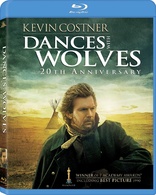
Movie rating
8.2 | / 10 |
Blu-ray rating
| Users | 4.5 | |
| Reviewer | 4.0 | |
| Overall | 4.1 |
Overview
Dances with Wolves (1990)
A Civil War lieutenant wants to see the American frontier before it is gone. He is assigned to an abandoned fort, where a Sioux tribe is his only neighbor.
Starring: Kevin Costner, Mary McDonnell, Graham Greene, Rodney A. Grant, Rodney A. GrantDirector: Kevin Costner
| Epic | Uncertain |
| Drama | Uncertain |
| Period | Uncertain |
| Western | Uncertain |
| Adventure | Uncertain |
Specifications
Video
Video codec: MPEG-4 AVC
Video resolution: 1080p
Aspect ratio: 2.36:1
Original aspect ratio: 2.39:1
Audio
English: DTS-HD Master Audio 7.1 (48kHz, 24-bit)
English: Dolby Digital 2.0 (224 kbps)
Subtitles
English SDH, French, Spanish
Discs
50GB Blu-ray Disc
Two-disc set (2 BDs)
Packaging
Slipcover in original pressing
Playback
Region A (locked)
Review
Rating summary
| Movie | 4.0 | |
| Video | 4.0 | |
| Audio | 4.0 | |
| Extras | 3.0 | |
| Overall | 4.0 |
Dances with Wolves Blu-ray Movie Review
Kevin Costner’s Americana epic sweeps magnificently onto Blu-ray.
Reviewed by Casey Broadwater January 10, 2011Both are three hour-plus epics, both contain action and capital-R-Romance in equal measure, and both are about a white American soldier “going native” and betraying his own race for the sake of justice, rightness, freedom, and love. So, why is it that James Cameron’s Avatar feels like a plasticine platitude, while Kevin Costner’s Dances with Wolves—even 20 years after its release—still seems genuine and wide-eyed, an honest statement about a regrettable period in U.S. history? I think it all comes down to ambition. Cameron’s film toted itself as a landmark leap forward in motion capture and the near-seamless blending of live-action cinematography and CGI—which it was and is—but its story is severely underwritten and overprocessed, cobbled together piecemeal from various anti-imperialist parables, including Dancing with Wolves. Compared to the years of research and development devoted to the film’s technological innovations, its script feels like an afterthought, an unfortunate necessity. Costner’s intent, on the other hand, was to tell a simple story simply, and Dances with Wolves definitely succeeds—it’s moving and grand, an American story writ large on the sweeping canvas of the Dakotas. The film is no work of cinematic genius—its flaws are more apparent in retrospect, and it’s nowhere near the David Lean-meets-John Ford masterpiece that some critics initially claimed it to be—but Kevin Costner’s directorial debut is more than competently told.
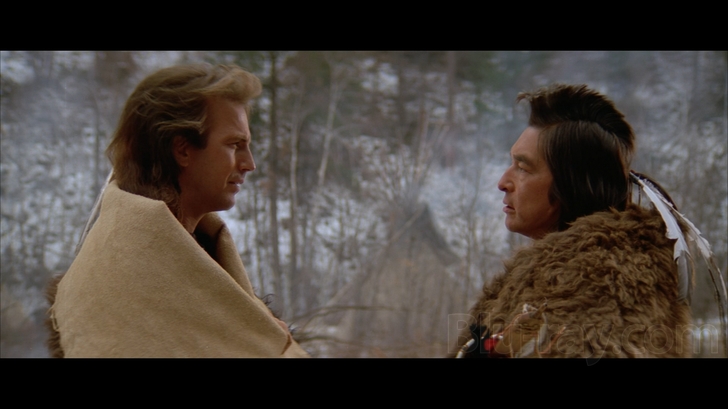
Dances with Wolves and Kicking Bird
The film begins on a scene of Stephen Crane-ish Civil War grisliness, as First Lieutenant John J. Dunbar (Costner) is prepped to lose his foot to a surgeon’s saw in a blood-spattered operating tent. When the medics slip out for coffee, Dunbar—prepared to die in a suicidal blaze of glory—steals a horse and rides across the battlefield toward the Confederate lines, inadvertently leading a charge that breaks the stalemate and wins the battle for the North. His supposed heroism nets him a medal and an even greater boon—a station at any Army outpost of his choosing. He picks Fort Sedgwick, an isolated post at the far edge of the western frontier—which Dunbar wants to see “before it’s gone”—but when he arrives, the fort is utterly deserted. Instead of turning back—which any sane 19th century person would do—Dunbar decides to make this dilapidated camp his hermitage. We know next to nothing about his past, but this is clearly a man who has had his share of civilization and found it lacking. Alone, but not lonely, he documents his time in a diary—which Costner reads in a somewhat stolid voiceover narration—befriends a wolf, and keeps a wary but curious watch on the Sioux tribesmen who obviously drove out his predecessors.
They’re eyeing him suspiciously as well. What’s a white guy doing all alone way out in the middle of nowhere? Is he crazy? Is he some sort of medicine man? Is he a threat? Fierce warrior Wind In His Hair (Rodney A. Grant) wants to ride in and fill Dunbar full of arrows, but holy man Kicking Bird (Graham Greene)—the clear-eyed old soul of the film—sees an opportunity to learn more about this peculiar white man and, by extension, all white men. In a series of cautious encounters, they attempt to communicate—their mutual good intentions made clear through some good old fashioned reciprocal gift giving—and soon enough Dunbar is spending most of his time at the Sioux encampment, learning their ways, tentatively speaking their language, and aiding them in their hunt for buffalo, scarce now that fur traders are slaughtering the noble beasts for their pelts and leaving their carcasses to rot out on the plains by the thousands. Of course, it’s unavoidable that Dunbar will fall in love with Stands with a Fist (Mary McDonnell), a white woman who was captured as a child during a raiding party and raised as a Sioux. Other inevitabilities also present themselves—a battle with the neighboring Pawnee tribe, a skirmish with the military, and Dunbar earning his honorary Sioux name, yes, Dances With Wolves.
By Hollywood logic, the film shouldn’t have been a seven-Academy-Award-winning success. It was directed by a young actor—and, come on, Kevin Costner is no Orson Welles—and it dared to be a three-hour long Western at a time when the genre was on the rocks. Not only that, but much of the dialogue is spoken in the Lakota dialect and subtitled in English, which, let’s face it, is a test of patience for an American moviegoing populace whose collective attitude is “if I wanted to read, I’d pick up a book.” Dances with Wolves works, however, precisely because, at the time, it’s not what you would’ve expected from an American epic. Even today, it stands outside the canon of supposedly stirring, cheesily patriotic dude films in which it’s usually lumped—Braveheart, The Patriot, etc.—for the sheer restraint and uncommon specificity that it shows. John Dunbar is no uber-masculine, nation-loving hero; like the film itself, he’s quiet, warm-hearted, and a little naďve—traits that Kevin Costner exemplifies well. The actor-turned-director has had his share of misses in the intervening years—we need not mention Waterworld —but here he shows visual acuity for the landscape of the West and a strong grasp of what makes a story resonate with an audience.
In this case, it’s pretty simple. Costner gives us well-developed characters that we can care about, and he casts their actions in a meaningful historical context. The film harkens back to the old Romantic notion that man is at his best when he’s at one with the natural world—although it’s less hippy-ish than the almost comically New Age-y Avatar—but it’s also honest about the realities of human nature, specifically man’s capacity for violence as a knee-jerk response to the fear of the unknown. While the movie is in some sense a revisionist western, sympathizing with the plight of the Native Americans, it shows both “sides,” if you will, the Sioux and the encroaching white civilization, as inherently afraid of—and brutal towards—one another. Dunbar and Kicking Bird, then, are presented as almost idealized human beings, capable of seeing past their respective cultures’ ingrained prejudices. Their relationship—not the romance between Dunbar and Stands With A Fist, which I’ve always felt is the movie’s weakest link—is the real backbone of the film.
This Blu-ray release of Dances with Wolves contains only the Director’s Cut, which runs six minutes shy of four hours long. It’s unfortunate that the shorter—and better—theatrical cut couldn’t also have been included via seamless branching, as the 55 minutes of added material slows down the picture dramatically and heightens some of the film’s flaws, like Costner’s tendency to linger unnecessarily on shots of wagons passing through the barren countryside or the script’s good-natured but occasionally cornball sentimentality. Still, this extended version does give the director opportunity to immerse us in Dunbar’s isolation and—when our protagonist finally finds a home amongst the Sioux—give us the sense that we’re making this journey into the wild with him.
Dances with Wolves Blu-ray Movie, Video Quality 
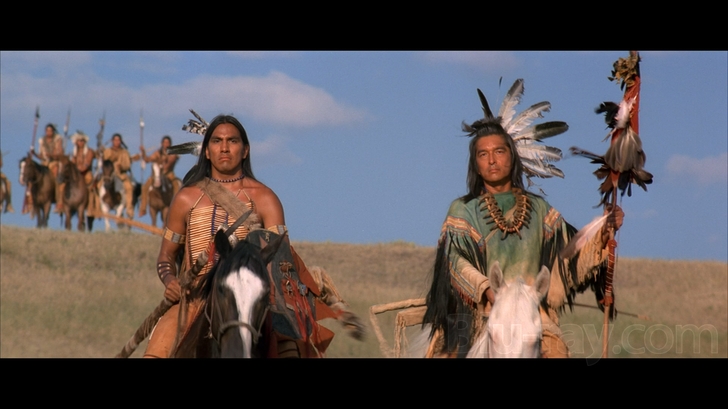
I've not seen the editions of Dances with Wolves that appeared on Blu-ray in Germany, France, and the U.K. in 2008 and 2009—so I can't make any direct comparisons—but I can say that MGM's 1080p/AVC-encoded transfer of the film is thoroughly impressive and well worth the upgrade from DVD. Of course, with four hours of material on a 50 GB disc, there are instances where light compression noise can be spotted amid the natural film grain—this is most apparent in darker interior scenes—but never to the point of distraction. On the whole, the film is beautifully resolved in high definition, with a surplus of textures that appear almost tactile, from the shaggy coarseness of buffalo wool and nubby softness of suede to the sharp patterns of tree bark and the weather-beaten faces of the Native American actors. Softness intrudes occasionally—once again, usually in darker indoor scenes—but you really wouldn't notice unless you were going out of your way to look for it. Color is stable and warm, with a preponderance of pale sky blues, rich neutral tones, and bright autumnal hues, and while black levels can sometimes appear deep grayish or crush shadow detail—yes, during those dark indoor scenes—contrast is otherwise perfect. Best of all, there's been no digital tampering here—no DNR, excess edge enhancement, boosting, or grading. Dances with Wolves is one of MGM's top-tier, tent-pole films, and the studio has given it the Blu-ray treatment that it deserves.
Dances with Wolves Blu-ray Movie, Audio Quality 

Just as impressive is the DTS-HD Master Audio 7.1 surround track that MGM has freshly whipped up for this 20th Anniversary release. With skirmishes, shootouts, and buffalo stampedes, the mix has plenty of opportunities to put the 7.1 presentation to immersive use. Bullets crack through the rears, horses bolt between channels, and the "tatanka" hunt is graced with an appropriately meaty low-end rumble as the buffalo move en masse over the plains. These action elements, however, constitute only a brief portion of the film. During the quieter, drama-driven scenes, the soundscape is just as astute, with bird song and insect noises filling the air, wind moving through tall grass, and rain pouring down all around. The only oddity I noticed is that you'll occasionally see something happening in front of you—in the "virtual" space, that is—but you'll also hear it behind you. Aside from these few anomalies, however, the mix is directionally accurate and consistently full of detail. Of course, some mention should be made of John Barry's now-iconic orchestral Americana score, which sounds as rich and dynamic here as you'd hope. Dialogue is clean and perfectly prioritized throughout, and do note that along with optional English SDH, Spanish, and French subtitles—which appear in white—lines spoken in the Sioux language are always translated in bright yellow lettering inside the 2.36:1-framed image.
Dances with Wolves Blu-ray Movie, Special Features and Extras 
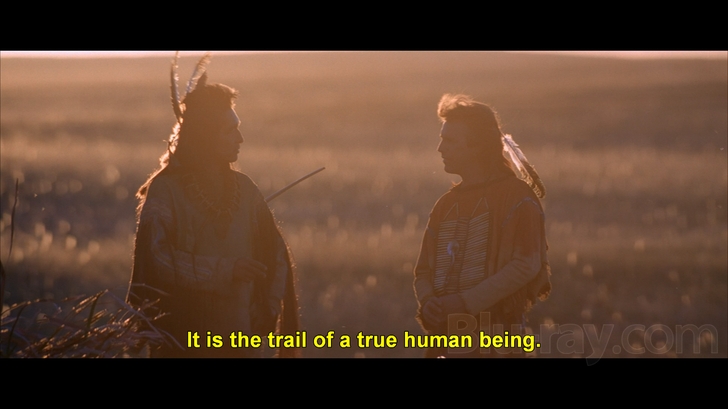
Spread across two Blu-ray discs, the bulk of Dances with Wolves' special features has been recycled from previous DVD iterations, but there
are a few new additions exclusive to this release, including two pop-up trivia/quiz modes and a featurette about life on the frontier.
Disc One
- Audio Commentaries: The disc comes with two previously recorded commentaries, one by Kevin Costner and Producer Jim Wilson, and another with Director of Photography Dean Semler and Editor Neil Travis. Both are chock full of pertinent and entertaining information, but given that the film runs for nearly four hours, there are understandably some slow patches.
- Military Rank and Social Hierarchy Guide: "This guide allows you to learn more about the roles, the era and the events that occurred during the historical period in which Dances with Wolves takes place," says the explanation on the menu. Basically, it's a variation on the old "pop-up trivia track," with a box at the bottom of the screen with icons for various military ranks, and corresponding factoids that pop up above at appropriate parts of the film. More of a distraction than anything, but it's there for those who want it.
- Real History or Movie Make-Believe?: A true-or-false quiz that "challenges your knowledge of the 19th century American military, the Lakota way of life, and the film." The questions appear in a box at the bottom of the screen while you're watching the film, and you have a limited amount of time to answer them. At the end of the movie, you're given a score. Does anyone do these kinds of quizzes?
- A Day in the Life on the Western Frontier (1080p, 14:18): In this all-new featurette, several historians guide us through what life would've been like for pioneers on the frontier.
- The Original Making of Dances with Wolves (SD, 20:58): A vintage behind-the-scenes documentary about the production of the film.
- The Creation of an Epic - A Retrospective Documentary (SD, 1:14:39): If you have a DVD copy of the film, you're probably already familiar with this seven part documentary, which revisits almost every aspect of the film, from the novel-to-screen adaptation and cinematography to the staging of the buffalo hunt and the film's ultimate success.
- Original Music Video Featuring Music by John Barry (SD, 3:52): I don't think I'd call this a "music video." It's more like an extremely poorly produced montage of behind-the-scenes clips and shots from the film set to John Barry's score.
- Second Wind (SD, 5:18): As best as I can figure it, this is a demo reel of Editor Neil Travis' work on the film.
- Confederate March and Music (SD, 2:13): Here, we see some haggard-looking Civil War reenactors line up for a dolly shot and then watch two of them play a little tune on a flute and snare drum.
- Getting the Point (SD, 3:58): A behind-the-scenes look at how one bow and arrow attack scene was shot.
- Burying the Hatchet (SD, 1:12): Likewise, a featurette showing how Hollywood hits a guy in the chest with ax without, you know, actually killing him.
- Animatronic Buffalo (SD, 2:18): No CGI was used in the making of the film, but KNB Effects did create a shaggy robot buffalo. See it in action!
- TV Spots (SD, 1:04): Includes two TV spots.
- Theatrical Trailer (1080p, 2:33)
- Poster Gallery (1080p): A user-directed gallery containing a whopping three images.
- Dances Photo Montage (SD, 9:21): A self-playing montage with introduction by still photographer Ben Glass.
Dances with Wolves Blu-ray Movie, Overall Score and Recommendation 
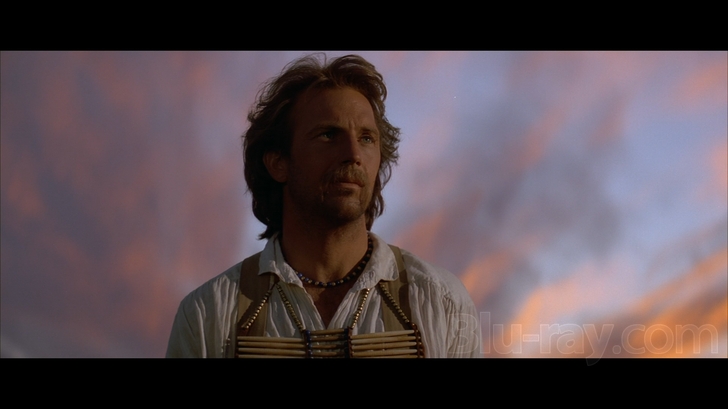
While I'd argue that the film probably didn't deserve to practically sweep the Academy Awards in 1990—it totally robbed GoodFellas and Martin Scorsese for Best Picture and Director—Dances with Wolves is undeniably one of the most lavish and loved films of its decade. I would've appreciated a disc that featured both the theatrical and director's cuts of the film, but MGM has nevertheless put together a fine Blu-ray package for this release, with a gorgeous high definition transfer, 7.1 lossless audio, and a variety of decent—albeit mostly recycled—extras. Recommended!
Other editions
Dances with Wolves: Other Editions

Dances with Wolves
TV Screen
1990

Dances with Wolves
Blu-ray + VUDU Digital Copy + VUDU Offer
1990

Dances with Wolves
MGM 90th Anniversary Edition
1990

Dances with Wolves
Limited Collector's Edition
1990

Dances with Wolves
1990

Dances with Wolves
Limited Collector's Edition
1990

Dances with Wolves
Limited Collector's Edition
1990

Dances with Wolves
25th Anniversary Edition
1990
Similar titles
Similar titles you might also like

The Good, the Bad and the Ugly 4K
Il buono, il brutto, il cattivo
1966

True Grit
2010

Once Upon a Time in the West 4K
Standard Edition | C'era una volta il West 4K
1968

For a Few Dollars More 4K
1965

Lonesome Dove
2-Disc Collector's Edition
1989

The Revenant 4K
2015

Once Upon a Time in America
Extended Director's Cut
1984

Ben-Hur
Fiftieth Anniversary
1959

Butch Cassidy and the Sundance Kid
1969

A Fistful of Dollars 4K
Per un Pugno di Dollari
1964

How the West Was Won
1962

A Passage to India
Collector's Edition
1984

Unforgiven 4K
1992

The Searchers 4K
Warner Archive Collection
1956

There Will Be Blood
2007

The Brutalist 4K
2024

Hostiles 4K
2017

The Proposition
2005

The Great Escape 4K
1963

The Master
2012